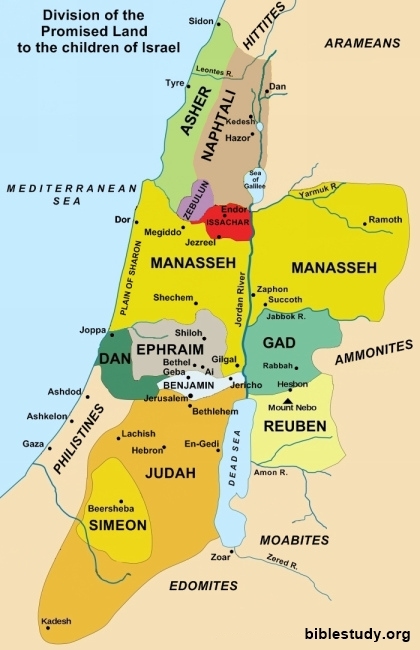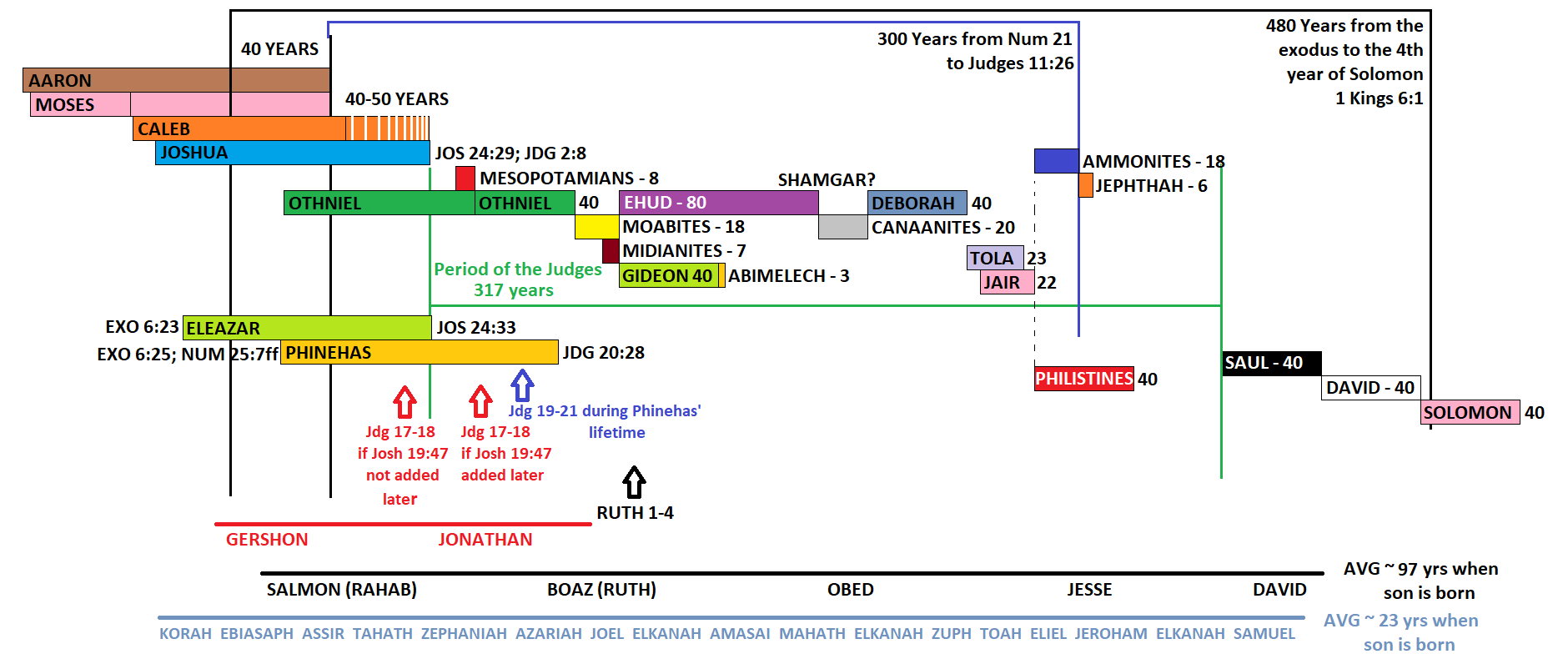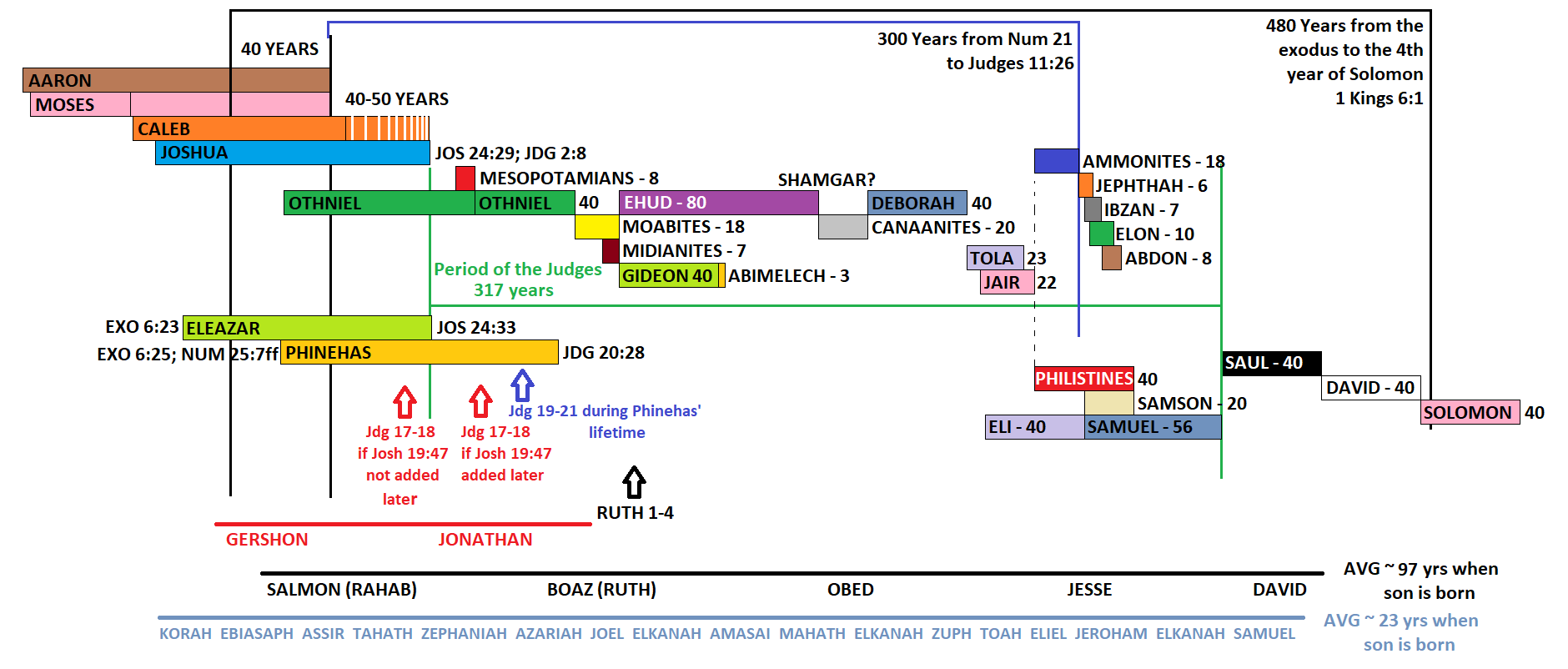Speculative Timeline of the Judges
Since we have only 317 years to place all these judges, and the times given add up to over 400 years, there must be some overlap involved here. What we will seek to answer here is where could there be room for such overlap. This is not the end-all-be-all for a timeline of the Judges, just a possibility to enter into your consideration.
How Long was Israel Faithful After Joshua?
We have already discussed some of the guesses we are forced to make based on the information given in Scripture. We are assuming Joshua was 30 when we first see him battle the Amalekites in Exodus 17, and that it was 10 years after Joshua’s death until the invasion of the Mesopotamians.
The range of possibilities extends from 0 to 35 years, but it is likely closer to 2 to 12 years. Why? First, there is a continuous block of time of Judges 3—5 encapsulates the Mesopotamian oppression to the end of the period of rest under Deborah which is 206 years. Second, the Ammonite oppression lasted 18 years before Jephthah’s timestamp of 300 years since Numbers 21 (so 299 years since the conquest begins). Third, we have already noted that Joshua’s period of rule was 40-50 years, depending on if he is 20 or 30 in Exodus 17. All this gives
299 – 40 – 206 – 18 = 35 ,
[25 years if Joshua ruled 50 years].
It’s got to be more than zero because it clearly states that time passes (Joshua 24:31; Judges 2:7, 10), but we’re not sure how much more. It’s got to be less than 35 years because there ought to be some gap for Tola and Jair (Judges 10:1-5). Tola is said to “save Israel,” though from whom we are not told. This means that this could not have been during a period of rest during another judge’s time. Tola and Jair could be concurrent judges since they are on different sides of the Jordan River, so the minimum time given is 23 years. That leaves at most 12 years if Joshua’s rule were only 40 years. Here, we are rounding to 10 for simplicity’s sake.
A Word on Language and Transitions
It is important to key in on words used to describe the transitions between these judges in the narrative. This will let us know if we have any wiggle room to move the judge somewhere different than where he falls in the narrative to fit in with a chronology.
“The land had rest / the country was quiet” (Jdg 3:11, 30; 5:31; 8:28). This does not indicate the lifespan of the judge associated with the period of rest, but surrounding phrases may indicate that. This simply states that there was no oppression during this time, but that toward the end of it, idolatry began again which led into the next oppression. For Gideon, it suggests it was quiet during his lifetime, but it could have been after as well, as we see with Abimelech.
“After him” (Jdg 3:31; 10:1, 3; 12:8, 11, 13). This indicates that what follows occurred after the previously mentioned judge began his judgeship. Shamgar arose after Ehud’s 80-year rest began. Tola arose sometime after Abimelech, but because of the placement I have for the Midianite oppression and Gideon’s rule, it was some time after Abimelech, not immediately after. Jair arose after Tola begins his judgeship, again, likely concurrently because of their areas of operation being on opposite sides of the Jordan (Tola: Ephraim; Jair: Gilead). Ibzan began after Jephthah began, Elon after Ibzan, and Abdon after Elon. It is likely Abdon (Ephraim) begins after Jephthah dies, otherwise there may have been a conflict between the two earlier in Judges 12.
“He [reigned over] judged Israel” (Jdg 9:22; 10:2, 3; 12:7, 9, 11, 14; 15:20; 16:31). This does not imply a period of rest, but that a period of overlap is possible. This could be a period of overlap among judges like the Tola, Jair, Jephthah, Ibzan, Elon, and Abdon, or a period of overlap with an oppression, as with Samson and the Philistines.
“Then the children of Israel did evil” (Jdg 6:1). I single this out because it partially gives my justification for moving the Midianite oppression and Gideon to be concurrent with the Moabite oppression and Ehud. “Then” suggests that this takes place after what was previously discussed. Surely, sometimes that is the case (e.g. Jdg 7:1), but only two major translations (NKJV, NASB) translate it as “then” in Judges 6:1. It seems clear that the Midianite oppression did not necessarily follow the period of rest of Deborah.
A Word on Geography
It has already been alluded to concerning different judges working in different areas. It should also be mentioned that there were likely not two or more judges working in the same area without the other being mentioned. This is one reason why I do not put Deborah and Gideon together because they are working in the same area of the north. Gideon could be concurrent with Ehud since Ehud worked in the central part of the nation, and could be why the Ephraimites were not originally contacted by Gideon (Jdg 7:24—8:3).
Jair and Jephthah are both from Gilead, and are therefore not likely to be concurrent judges. Jephthah and Abdon are not likely concurrent since Jephthah’s war with Ephraim would have put him at odds with Abdon.
The Ammonite and Philistine oppressions that began after Jair (Jdg 10:6-9) are concurrent oppressions. The Ammonites oppressed the area of Gilead which Jephthah had delivered them from. Ibzan, Elon, and Abdon all served during the Philistine oppression, though it is unclear how they were fighting against them, if at all. Elon was from Zebulun and likely never dealt with the Philistines at all, since they are in the south and central areas of Canaan. Samson, Eli, and Samuel dealt with the Philistines in these areas.
From Othniel to Deborah
Ten years after Joshua dies, the Mesopotamians invaded and oppressed the Israelites for 8 years. Othniel, Caleb’s nephew and son-in-law living in Judah, delivers them with a period of rest for 40 years.
Near the end of those 40 years, the Israelites fall back into idolatry, including the idolatry of Micah in Ephraim and the theft of this idol by the Danites migrating north. There are still some sins that are a bridge too far for most of the Israelites, such as the abominations of Benjamin. Benjamin is all but wiped out, but a few survive and wives are “acquired” for them. One of the products of these events is Ehud. As a result of their sin, the Moabites, the Amalekites, the Ammonites, and later the Midianites oppress them for 18 years. Midian is only involved for 7 of those years. Famine strikes Israel as far as Gaza because the oppressors destroyed their crops and flocks. This prompts Elimelech from Bethlehem to move to Moab with his family for ten years, and he and his sons die.
Fig. 5 – Here we have the judges from Othniel to Jephthah.
Ehud delivers the south and central areas of Israel by killing Eglon king of Moab in the City of Palms (near Jericho). He amasses an army in the mountains of Ephraim to drive the Moabites, Ammonites, and Amalekites out. The narrative focuses on Moab because Ehud killed their king. Ehud’s period of rest lasted 80 years. During this time, Naomi returns to Bethlehem with Ruth and Ruth marries Boaz.
Gideon encounters the Angel of the Lord, destroys his father’s idol, and delivers the area in the north, particularly in the Valley of Jezreel, with 300 men, sometime after his brothers were killed by the Midianites. He gathered men from Naphtali, Asher, and Manasseh and chased the Midianites down through Gilead, eliciting the help of the Ephraimites for the Midianites who fled there. He punishes Succoth and Penuel, cities in Gilead which did not help him in his pursuit. During his 40 years of rest, the Israelites want to make him a king, but he makes a golden ephod instead. He still acts like a king with his many wives and concubines.
One of Gideon’s sons through his concubine at Shechem was Abimelech who killed all his brothers save one so he could reign, and does so for 3 years. The youngest brother calls a curse on him which is enacted by the unrest between him and his home base of Shechem. Shechem is destroyed, and Abimelech is later killed by a woman when trying to take Thebez.
The golden ephod of Gideon became a snare to the people in the north, and as punishment for the idolatry that encouraged, God sent the Canaanites, including the Sidonians (Jdg 10:12), under Jabin king of Hazor to oppress the people. During this time, the Philistines attempt to invade Israel, but Shamgar beats them back, killing 600 of them with an ox goad. A portrait of what life was like during Shamgar’s time is sung about in Judges 5:6-7 when Deborah begins to judge. Deborah judges in Ephraim, and after 20 years of oppression, calls upon Barak in Naphtali to lead the people in battle. He refuses to go without her, so Deborah prophesied that Sisera, Jabin’s general, would be killed by a woman. Sisera confronts Barak at Mount Tabor, and Barak beats him back with men from Ephraim, Benjamin, Machir, Zebulun, Issachar, and Reuben, forcing him to flee. Sisera takes refuge in an ally’s tent, only to be killed by his ally’s wife Jael. The land has rest for 40 years.
Fig. 6 – Shown below now includes the judgeships of Jephthah, Ibzan, Elon, and Abdon. Much of this is speculation, though Abdon is likely not contemporary with Jephthah. Eli judges long before the Philistine oppression. Samson and Samuel are about the same age, both births announced to their parents at the same time. Samson softened up the Philistines before Samuel finally delivers Israel from them. Samuel judges all the days of his life (1 Sam. 7:15), about 36 years between deliverance from the Philistines and the reign of Saul.


